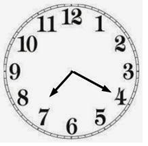Science > Mathematics > Trigonometry > Angle Measurement > Angle Measurement
In this article, we shall study the problems based on the interior angles of a polygon, and the angle between the hour hand and a minute hand of a clock.
Example – 01:
If xc = 405° and y° = – (π/12)c. Find x and y
Solution:
Given xc = 405°
x containing term on R.H.S. is in radians. Hence we should convert L.H.S. into radians
∴ xc = 405° = 405 x π/180 = (9π/4)c
∴ x = 9π/4
Given y° = – (π/12)cy containing term on R.H.S. is in degrees. Hence we should convert L.H.S. into degrees
∴ y° = – (π/12)c = – (π/12) x (180/π) = 15°
∴ y = 15
Ans: x = 9π/4 and y = 15
Example – 02:
If θ° = – (5π/9)c and Φc = 900°. Find θ and Φ
Solution:
Given θ° = – (5π/9)c
θ containing term on R.H.S. is in degrees. Hence we should convert L.H.S. into degrees
∴ θ° = – (5π/9)c = – (5π/9) x (180/π) = – 100°
∴ θ = -100
Given Φc = 900°
Φ containing term on R.H.S. is in radians. Hence we should convert L.H.S. into radians
∴ Φc = 900° = 900 x π/180 = (5π)c
∴ Φ = 5π
Ans: θ = -100 and Φ = 5π
Example – 03:
Express following angles in radians
– 35°45’30”
Solution:
– 35°45’30” = – [35° + (45/60)° + (30/3600)°]
– 35°45’30” = – [35° + 0.75° + 0.0083°] = – 35.7583°
– 35°45’30” = – 35.7583 x π/180 = 0.1987 π
– 35°45’30” = 0.1987 x 3.142 = 0.6242 radian
50°37’30”
Solution:
50°37’30” = 50° + (37/60)° + (30/3600)°
50°37’30” = 50° + 0.6167° + 0.0083° = 50.625°
50°37’30” = 50.625 x π/180 = 0.2812 π
50°37’30” = 0.2812 x 3.142 = 0.8837 radian
– 10°40’30”
Solution:
10°40’30” = 10° + (40/60)° + (30/3600)°
10°40’30” = 10° + 0.6667° + 0.0083° = 10.675°
10°40’30” = 10.675 x π/180 = 0.0593 π
10°40’30” = 0.0593 x 3.142 = 0.1863 radian
Interior Angle of Regular Polygon:
Steps to Find Interior Angle of Polygon:
- Find the measure of each exterior angle of regular polygon = 360°/No.of sides of polygon
- Find the measure of each interior angle of polygon = 180° – measure of exterior angle
Example – 04:
Find Interior angles of following regular polygons in degrees and radians
Pentagon:
Solution:
Pentagon has 5 sides
Each exterior angle = 360°/5 = 72°
Each interior angle = 180° – 72° = 108° = 108 x π/180 = (3π/5)c
Ans: The interior angle of a regular pentagon is 72° or (3π/5)c
Hexagon:
Solution:
Hexagon has 6 sides
Each exterior angle = 360°/6 = 60°
Each interior angle = 180° – 60° = 120° = 120 x π/180 = (2π/3)c
Ans: The interior angle of a regular hexagon is 120° or (2π/3)c
Octagon:
Solution:
Octagon has 8 sides
Each exterior angle = 360°/8 = 45°
Each interior angle = 180° – 45° = 135° = 135 x π/180 = (3π/4)c
Ans: The interior angle of a regular octagon is 135° or (3π/4)c
A Polygon with 20 sides:
Solution:
Polygon has 20 sides
Each exterior angle = 360°/20 = 18°
Each interior angle = 180° – 18° = 162° = 162 x π/180 = (9π/10)c
Ans: The interior angle of a regular polygon with 20 sides is 162° or (9π/10)c
A Polygon with 15 sides:
Solution:
Polygon has 15 sides
Each exterior angle = 360°/15 = 24°
Each interior angle = 180° – 24° = 156° = 156 x π/180 = (13π/15)c
Ans: The interior angle of a regular polygon with 15 sides is 156° or (13π/15)c
A Polygon with 12 sides:
Polygon has 12 sides
Each exterior angle = 360°/12 = 30°
Each interior angle = 180° – 30° = 150° = 150 x π/180 = (5π/6)c
Ans: The interior angle of a regular polygon with 12 sides is 150° or (5π/6)c
Example – 05:
Find the number of sides of polygon if each of its interior angle is (3π/4)c.
Solution:
Each interior angle = (3π/4)c = (3π/4) x (180/π) = 135°
Hence each exterior angle = 180° – 135° = 45°
Number of sides of polygon = 360°/each exterior angle = 360°/45 = 8°
Ans: Thus the polygon has 8 sides
Angle Between Hour Hand and Minute Hand:
Example – 06:
Find the degree and radian measure of the angle between the hour hand and minute hand of a clock at the following timings.
Twenty minutes past seven:
Solution:

At twenty minutes past seven, the minute hand is at 4 and hour hand crossed 7
Angle traced by hour hand in 1 minute = 0.5°
Angle traced by hour hand in 20 minutes = 0.5° x 20 = 10°
Thus the hour hand is 10° ahead of 7 th Mark
The angle between 4 and 7 is 90°
Thus angle between hour hand and minute hand = 90° + 10° = 100°
100° = 100 x π/180 = (5π/9)c
Ans: The angle between the hour hand and the minute hand is 100° or (5π/9)c
Twenty minutes past two:
Solution:

At twenty minutes past two, the minute hand is at 4 and hour hand crossed 2
Angle traced by hour hand in 1 minute = 0.5°
Angle traced by hour hand in 20 minutes = 0.5° x 20 = 10°
Thus the hour hand is 10° ahead of 2 nd Mark
The angle between 2 and 4 is 60°
Thus angle between hour hand and minute hand = 60° – 10° = 50°
50° = 50 x π/180 = (5π/18)c
Ans: The angle between the hour hand and the minute hand is 50° or (5π/18)c
Quarter past six:
Solution:

At quarter past six, the minute hand is at 3 and hour hand crossed 6
Angle traced by hour hand in 1 minute = 0.5°
Angle traced by hour hand in 15 minutes = 0.5° x 15 = 7.5°
Thus the hour hand is 7.5° ahead of 6th Mark
The angle between 3 and 6 is 90°
Thus angle between hour hand and minute hand = 90° + 7.5° = 97.5°
97.5° = 97.5 x π/180 = (13π/24)c
Ans: The angle between the hour hand and the minute hand is 97.5° or (13π/24)c
Ten past eleven:
Solution:

At ten past eleven, the minute hand is at 2 and hour hand crossed 11
Angle traced by hour hand in 1 minute = 0.5°
Angle traced by hour hand in 10 minutes = 0.5° x 10 = 5°
Thus the hour hand is 5° ahead of 11th Mark
The angle between 11 and 2 is 90°
Thus angle between hour hand and minute hand = 90° – 5° = 85°
85° = 85 x π/180 = (17π/36)c
Ans: The angle between the hour hand and the minute hand is 85° or (17π/36)c
Example – 07:
Show that the minute hand of a clock gains 5°30′ on hour hand in one minute.
Solution:
Angle traced by hour hand in 1 minute = 0.5°
Angle traced by minute hand in 1 minute = 6°
Thus angle between hour hand and minute hand = 6° – 0.5° = 5.5° = 5°30′
Ans: Thus the minute hand of a clock gains 5°30′ on hour hand in one minute.
Example – 08:
Determine which of the following pairs of angles are coterminal.
210° and – 150°
– 150° = – 150° + 360° = 210°
Thus the two angles have the same initial arm and terminal arm.
Hence the angles 210° and – 150° are coterminal angles.
330° and – 60°
– 60° = – 60° + 360° = 300°
Thus the two angles do not have the same initial arm and terminal arm.
Hence the angles 330° and – 60° are not coterminal angles.
405° and – 675°
405° = 405° – 360° = 45°
– 675° + 360° x 2 = 45°
Thus the two angles have the same initial arm and terminal arm.
Hence the angles 405° and – 675° are coterminal angles.
1230° and – 930°
1230° = 1230° – 360° x 3 = 150°
– 930° + 360° x 3 = 150°
Thus the two angles have the same initial arm and terminal arm.
Hence the angles 1230° and – 930° are coterminal angles.
Example – 09:
A wheel makes 360 revolutions in one minute. Through how many radians does it turn in 1 second?
Given: No. of revolutions = 360 per minute
To Find: Radians per second =?
Solution:
No. of revolutions per second = 360/60 = 6
In one revolution the wheel turns through 2π radians
Radians per second = 2π x 6 = 12πc
Ans: The wheel will turn through 12πc in 1 second